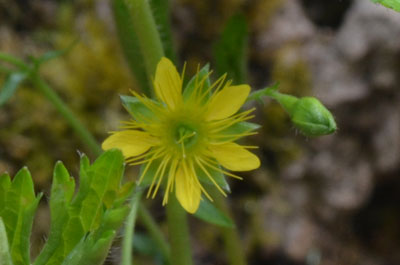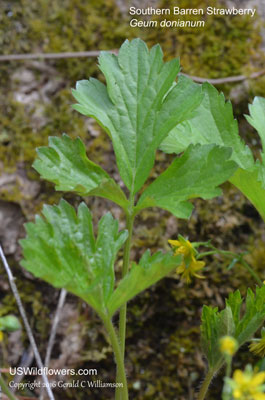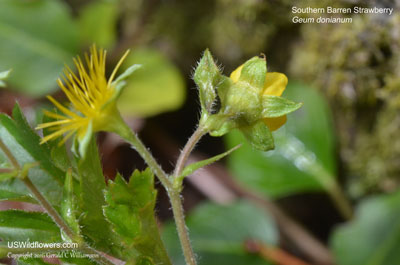Wildflowers of the United States | |||||||||||||
| |||||||||||||
Geum donianum - Southern Barren Strawberry, Appalachian Barren Strawberry, Small-petaled Barren Strawberry. | The Barren Strawberry genus (Waldsteinia) has had a pretty confusing history of classification, and it appears that it may no longer exist, with most authorities now agreeing that it needs to be placed within Geum - Avens. Even when they were separated into Waldsteinia, there was much confusion as to whether Northern and Southern Barren Strawberry should be combined into a single species as Waldsteinia fragarioides or to separate Southern Barren Strawberry into its own genus, either as W. parviflora or as W. donianum. Finally in the 21st century, after genetic study and much discussion on the names, most (not all) authorities that care seem to agree that Waldsteinia should be combined with Geum, although with deciduous style (the rest of the Geum has a persistent style), in its own subgenus - Waldsteinia. Most publications still classify these plants in Waldsteinia, and the USDA map shown to the right combines Northern and Southern Barren Strawberry into a single genus. Geum donianum - Southern Barren Strawberry - differs from Geum fragarioides - Northern Barren Strawberry - most obviously (if that term can be used) in the size of the flower, most easily noted by the petal size relative to the sepal size, with the petals of G. donianum being shorter than to just a bit longer than the sepals, and those of G. fragarioides being distinctly longer than the sepals. Their ranges overlap in Kentucky, Virginia, Tennessee, and North Carolina. There is another species (G. lobatum) in a small area of the southern Appalachians which has deeply lobed rather than compound leaves, and one in Idaho and Montana (G. idahoensis with shallower lobes and larger flowers. Synonym: Waldsteinia fragarioides var. parviflora, Waldsteinia parviflora. Found in: AL, AR, CT, GA, IL, IN, KY, MA, MD, ME, MI, MN, MO, NC, NH, NJ, NY, OH, PA, SC, TN, VA, VT, WI, WV, GS (This list and the USDA map show the distribution for the combined G. donianum and G. fragarioides, since they are so similar and many publications combine them.) Leave comments on Geum donianum at this link.   Blue=Native; Grey=Introduced Map from USDA Plants Database: USDA, NRCS. 2017. The PLANTS Database (http://plants.usda.gov, 08 May 2025). National Plant Data Team, Greensboro, NC 27401-4901 USA. Search Our Database: Enter any portion of the Scientific, Common Name, or both. Do a general Google search of the entire site: #ad
| #ad
| | ||||||||||
|
Commercial / Cookie Notice Looking for Wildflowers for a specific state? Check here: | |||||||||||||
|
| |||||||||||||




